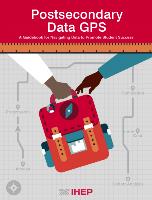Postsecondary Data GPS Gives Data Users Direction
Have you ever wondered how to increase data use beyond compliance? Have you struggled to connect your institution’s data with student success initiatives? After hearing from institutions looking to improve data use on campus, the Institute for Higher Education Policy (IHEP) created the Postsecondary Data GPS – a free guidebook that shows how institutions can operationalize the Postsecondary Metrics Framework by framing key questions colleges should be asking of themselves and their data and offering data visualization tools to help navigate change management and student success efforts. We designed the GPS to be accessible to anyone with an interest in data use to increase student outcomes, regardless of analytic capability or office size.
struggled to connect your institution’s data with student success initiatives? After hearing from institutions looking to improve data use on campus, the Institute for Higher Education Policy (IHEP) created the Postsecondary Data GPS – a free guidebook that shows how institutions can operationalize the Postsecondary Metrics Framework by framing key questions colleges should be asking of themselves and their data and offering data visualization tools to help navigate change management and student success efforts. We designed the GPS to be accessible to anyone with an interest in data use to increase student outcomes, regardless of analytic capability or office size.
Data are critical for closing achievement gaps in higher education. Colleges and universities that narrow gaps between low-income students, students of color, and their peers invariably cite data as an essential tool that enabled their success. Data, when complete and inclusive, allow institutional researchers to understand the gaps and barriers their students face, empower administrators to develop targeted solutions to improve student success, and aid in self-reflection and assessment of existing practices. Seeing these successes, many institutions want to explore student success data but do not know how to start, where to look, or whether they have the capacity to take on additional analysis beyond compliance.
We wrote the Postsecondary Data GPS (GPS) to address those challenges.
Designed to be easily navigable, this online tool outlines key metrics that institutions should collect and analyze to delve into college access, progression, completion, and cost gaps. The GPS also includes the resources necessary to examine an entire class’s college experience—from admission through completion—using a cohort-level metanalysis. We embedded downloadable Excel templates in each chapter to enable staff of every skill level to easily produce presentation-quality graphics and analyses with aggregate data—even with the most limited of resources. Further, the GPS provides questions that everyone on campus—from researchers to institutional leaders—should be asking in order to push their data as far as it can go to support student success efforts.
We supplemented these resources with real data from the City University of New York (CUNY) college system and information gleaned from interviews with practitioners who are well versed in working with these types of data.
Among institutional researchers’ many responsibilities, one of the most important is to be an agent of change on their campus and in the field. In order to promote equity and ensure success for all students, particularly those who have been under-served by our higher education systems, institutions and other policymakers need data to understand how students are accessing, progressing, and succeeding at our institutions. Institutional researchers can provide that information—and the GPS will help.
By asking essential questions about how students move to and through the postsecondary pipeline, researchers like you will be able to help your institutions understand whether they are equitably serving students and, ultimately, help them to improve, ensuring all students can realize the promise of postsecondary education.
Data’s potential for impact is huge but the burden of navigating it shouldn’t be. Data can be a tool for positive change, and we designed the GPS to help you facilitate it.
The Institute for Higher Education Policy (IHEP) manages the Postsecondary Data Collaborative, an initiative that advocates for high-quality postsecondary data.
